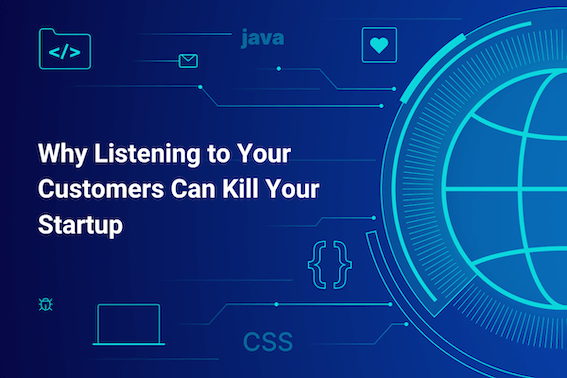Here’s a scenario that may seem familiar: you’ve just launched your SaaS startup, and those first few customers feel like a dream come true. Their feedback pours in, and it’s tempting to treat each suggestion like gospel. After all, they’re the ones using your product, right? Bending over backward to please them seems like a no-brainer, and you start changing your product. But then, people start to complain—or don’t sign up at all.
The kicker is that roughly 90% of startups don’t make it—and here’s why. Many falter because they get too caught up in catering to those early adopters. Sure, their input is valuable, but it can also be a trap that leads you down rabbit holes of endless customization instead of focusing on building a product with real staying power.
The truth is, creating a successful startup isn’t just about listening to all of your customers’ feedback—it’s about listening intelligently and aiming for product-market fit. It’s about understanding who your ideal customers really are and what they truly need, even if they haven’t quite figured it out themselves.
The question is, how do you avoid the pitfalls of listening to your customers and instead steer your startup toward the growth you’re dreaming of?
The Dangers of Over-Customizing for Early Adopters
In the infancy of a startup, the feedback loop often becomes intensely focused on a handful of initial clients. These early adopters are excited by the novelty and potential of your product, and are quick to offer suggestions and critiques. Their voices are amplified by the relative silence of the broader market and, as a result, can far too easily become the driving force behind product decisions.
Influential clients, in particular, can wield significant power. Their enthusiasm, coupled with their willingness to pay, makes it tempting to prioritize their specific needs and requests. This can lead startups to chase short-term wins by tailoring their product to fit niche requirements rather than focusing on a broader, more sustainable strategy that aims for product-market fit.
However, this approach carries substantial risks. By catering to the whims of a few early clients, startups risk developing a product that is overly customized, fragmented, and ultimately misaligned with their target market’s needs. This not only leads to wasted resources and missed opportunities, but can also cause a loss of focus and strategic direction. In the pursuit of immediate gratification, startups can lose sight of their long-term vision—leading to a product that is neither scalable nor sustainable.
On the flip side, ignoring your customers’ feedback can be equally detrimental. Studies show that 14% of startups fail because they do not regard their customers’ needs. This underscores how critical it is to strike a balance: listening to feedback—but not letting it dictate every product decision.
Navigating with a Clear Product Roadmap
To avoid the pitfalls of over-customization and short-term thinking, a clear and well-defined product roadmap is essential.
Your roadmap acts as a strategic compass, ensuring your development efforts align with the broader market needs and focus on achieving product-market fit, not just the immediate desires of your early adopters. However, creating a truly effective roadmap requires a thorough understanding of your target market, their pain points, and the competitive landscape.
Skipping this crucial research phase and opting to rely solely on early feedback is like sailing without a map. You might find yourself building a product that solves a problem that doesn’t exist, or one that doesn’t resonate with your target audience. Your messaging can become muddled, lacking the clarity and focus needed to cut through the noise and attract your ideal customers.
Furthermore, prioritizing the feedback of a few early adopters without proper research can create ‘legacy issues’ that hinder your startup’s growth. These issues can manifest as technical debt, where hasty customizations and quick fixes lead to a complex codebase that’s difficult to maintain and scale. They can also result in a misaligned market position, where your product is perceived as a niche solution and limits your potential for expansion.
Developing an ICP Is the Key
To set your startup on a path of sustainable growth, you need to understand who you’re truly building for. This means developing a detailed and accurate Ideal Customer Profile (ICP). Your ICP isn’t just a generic demographic sketch; it’s a deep dive into the motivations, challenges, and aspirations of your perfect customer.
Defining your ICP starts with understanding their pain points:
- What are the day-to-day challenges they face?
- What keeps them up at night?
- What are their unfulfilled needs?
Understanding their pain points allows you to properly customize your product and messaging to address those specific needs and work towards achieving product-market fit.
There are various techniques for researching your target personas. One approach is to analyze LinkedIn profiles of individuals who fit your ideal customer description. Look at their job titles, skills, and interests to gain insights into their professional lives. Industry reports and market research publications can also provide valuable data on customer preferences and demographics.
However, the most illuminating technique is conducting customer interviews. Speaking directly with potential customers provides firsthand knowledge of their pain points, their decision-making processes, and their expectations for your product. This qualitative data can be invaluable in shaping your product roadmap and marketing strategy.
The Goal: Research-Driven Product Development
Armed with your ICP and a deep understanding of their pain points, it’s time to translate that knowledge into a product. But before jumping into development, start by formulating a hypothesis based on your research. This hypothesis should be a testable assumption about how your product will address the target market’s needs and help you achieve product-market fit.
Next, engage with design partners—a select group of individuals who represent your ideal customers. The goal here isn’t to have them dictate your product roadmap, but rather to validate your hypotheses. Their feedback can help you refine your understanding of their needs and ensure your product is on the right track.
Remember, not all feedback is created equal. It’s crucial to distinguish between valuable feedback that aligns with broader market needs and noise that might lead you astray.
Valuable feedback is often rooted in the pain points you’ve identified during your research. It’s specific, actionable, and resonates with multiple design partners. On the other hand, noise is often anecdotal, subjective, and lacks broader relevance.
A product-led growth strategy can be particularly beneficial in this phase, as it leverages the product itself to drive customer acquisition, retention, and expansion. Focusing on building a product that users love and share can achieve sustainable growth that’s driven by the product’s inherent value.
Balancing Customer Feedback with Strategic Vision
Listening to your customers is crucial, but it’s equally important to filter and balance their feedback against your strategic product roadmap. Remember, your roadmap is your guide, keeping you focused on your long-term vision.
However, a well-crafted roadmap isn’t set in stone. If you consistently receive feedback from multiple design partners that highlights a significant gap or opportunity, it might warrant altering your roadmap. These adjustments should be strategic, so ensure they align with your overall vision and serve the broader market needs you’ve identified through research.
It’s a delicate balancing act. You need to be open to valuable feedback that can improve your product, but you also need to maintain focus on your strategic goals.
Don’t get sidetracked by every suggestion or complaint. Instead, look for patterns and recurring themes that align with your research and validate your assumptions. This way, you can evolve your product while staying true to your vision and ensuring product-market fit.
Steer Your Startup Toward Long-Term Growth
While early customer feedback is undoubtedly valuable, it’s not the sole determinant of your startup’s success. Over-reliance on the opinions of a few can lead you down a path of endless customization, misaligned product development, and stunted growth.
The key to building a thriving startup lies in striking a balance. It’s about combining thorough market research, a clear strategic vision, and selective, validated customer feedback to achieve product-market fit. This balanced approach ensures you’re not only building a product your customers want, but one that meets the broader market needs, generates demand, and steers you on a trajectory for long-term growth.
Ultimately, listening to your customers shouldn’t kill your startup—it should help it succeed. If you’re unsure how to navigate this delicate balance, don’t hesitate to seek expert guidance. At mvpGrow, we specialize in helping startups develop research-driven growth strategies and product roadmaps that align with market realities. Our global team offers proven on-demand startup marketing services that scale your business and boost revenue. Book a free consultation with mvpGrow today to start building a future of growth for your startup.

The Founder & Chief Getting Sh%T Done Officer of mvpGrow. After about 8 years as a hired hand some of the largest (and smallest) B2B SaaS companies worldwide I decided to hang up my employee slippers and lace up my growth agency cleats. But just because I’m an agency doesn’t mean we can’t chat (no charge). Please email me on any topic and I will gladly reply: eyal@mvpgrow.com

